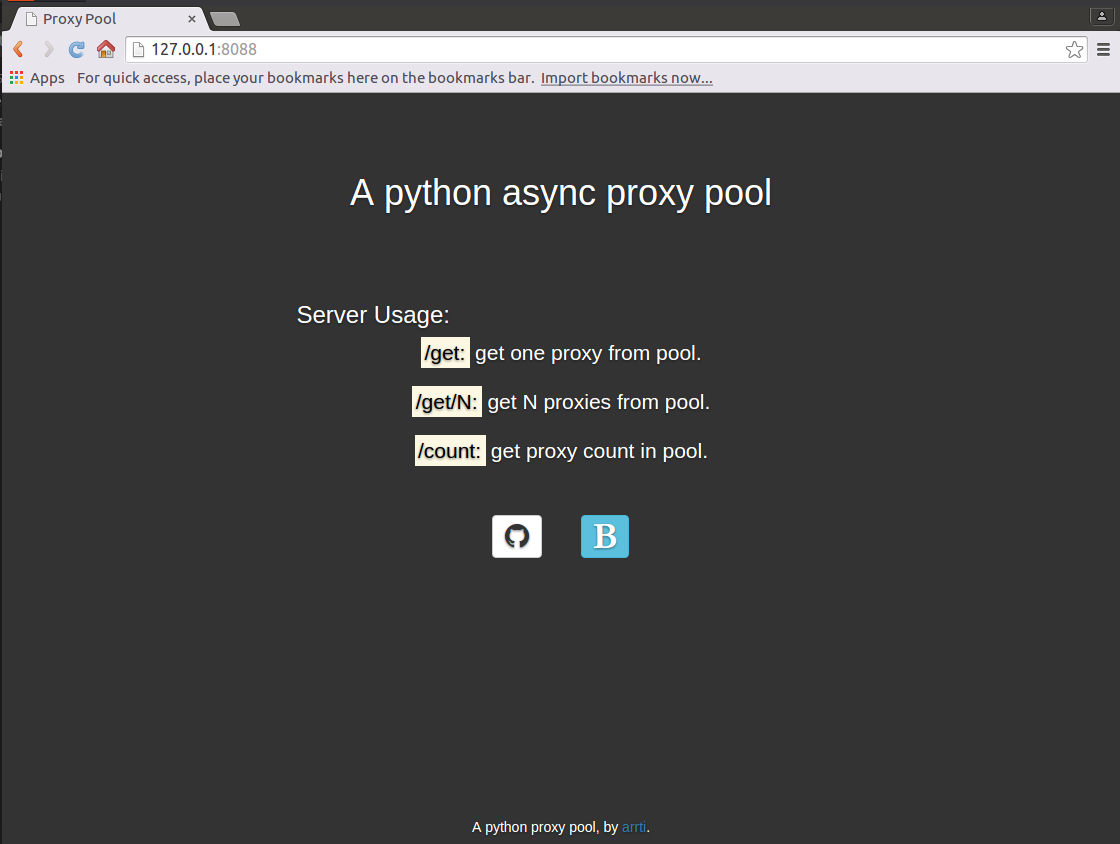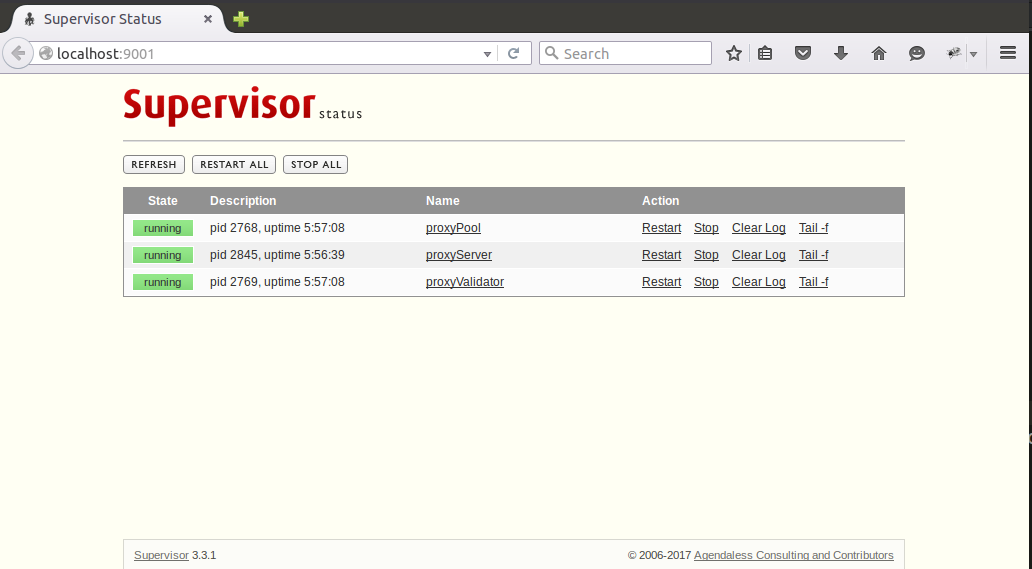 Backend Development
Backend Development
 Python Tutorial
Python Tutorial
 Using Python to implement asynchronous proxy crawler and proxy pool methods
Using Python to implement asynchronous proxy crawler and proxy pool methods
Using Python to implement asynchronous proxy crawler and proxy pool methods
This article mainly introducesPythonRelevant knowledge about implementing asynchronous proxy crawlers and proxy pools, which has a good reference value. Let’s take a look at it with the editor
Use python asyncio Implemented an asynchronous proxy pool, crawled free proxies on the proxy website according to the rules, and stored them in redis after verifying their validity. Regularly expanded the number of proxies and checked the validity of proxies in the pool, and removed them. Invalid proxy. At the same time, a server is implemented using aiohttp, and other programs can obtain the proxy from the proxy pool by accessing the corresponding URL.
Source code
https://github.com/arrti/proxypool
Environment
Python 3.5+
Redis
PhantomJS (optional)
Supervisord (optional)
Because the code uses asyncio’s async and await syntax extensively, they are only available in Python3.5 provided, so it is best to use Python 3.5 and above. I am using Python 3.6.
Dependencies
redis
aiohttp
bs4
- ##lxml ##requests
- selenium
- The selenium package is mainly used to operate PhantomJS.
The code is explained below.
1. Crawler part
Core code
1 2 3 4 5 6 7 8 9 10 11 12 |
|
implemented using asyncio.Queue. The following is a simple implementation of this model:
1 2 3 4 5 6 7 8 9 10 11 12 13 14 15 16 17 18 19 20 21 22 23 24 25 26 27 |
|
1 2 3 4 5 6 7 8 9 10 |
|
Crawling pages
1 2 3 4 5 6 7 8 9 10 11 12 13 14 15 16 17 18 19 20 21 |
|
, most proxy websites can use the above method to crawl, for websites that use js to dynamically generate pages, you can use selenium to control PhantomJS to crawl - this project does not have high requirements for the efficiency of the crawler. The update frequency of the proxy website is limited, and frequent crawling is not required. You can use PhantomJS.
Parse the proxyThe easiest way is to use
xpathto parse the proxy. If you use the Chrome browser, You can get the xpath of the selected page element directly by right-clicking:
 Install the Chrome extension "XPath Helper" to run and run directly on the page Debugging xpath is very convenient:
Install the Chrome extension "XPath Helper" to run and run directly on the page Debugging xpath is very convenient:
 BeautifulSoup does not support xpath and uses lxml to parse the page. The code is as follows:
BeautifulSoup does not support xpath and uses lxml to parse the page. The code is as follows:
1 2 3 4 5 6 7 8 9 10 11 12 13 14 15 16 17 18 19 20 21 22 |
|
Crawler rules The rules for website crawling, proxy parsing, filtering, and other operations are defined by the rule classes of each proxy website. Metaclasses and base classes are used to manage rule classes. The base class is defined as follows:
1 2 3 4 5 6 7 8 9 10 11 12 |
|
The meaning of each parameter is as follows:
start_url(required)The starting page of the crawler.
(required)XPath rules for crawling IP.
(required)XPath rules for crawling port numbers.
The number of crawled pages.
Format of page address
, generate the address of page n through urls_format.format(start_url, n), this It is a relatively common page address format.
next_page_xpath, next_page_host<p>由xpath规则来获取下一页的url(常见的是相对路径),结合host得到下一页的地址:next_page_host + url。</p><p><code>use_phantomjs, phantomjs_load_flag
use_phantomjs用于标识爬取该网站是否需要使用PhantomJS,若使用,需定义phantomjs_load_flag(网页上的某个元素,str类型)作为PhantomJS页面加载完毕的标志。
filters
过滤字段集合,可迭代类型。用于过滤代理。
爬取各个过滤字段的xpath规则,与过滤字段按顺序一一对应。
元类CrawlerRuleMeta用于管理规则类的定义,如:如果定义use_phantomjs=True,则必须定义phantomjs_load_flag,否则会抛出异常,不在此赘述。
目前已经实现的规则有西刺代理、快代理、360代理、66代理和 秘密代理。新增规则类也很简单,通过继承CrawlerRuleBase来定义新的规则类YourRuleClass,放在proxypool/rules目录下,并在该目录下的init.py中添加from . import YourRuleClass(这样通过CrawlerRuleBase.subclasses()就可以获取全部的规则类了),重启正在运行的proxy pool即可应用新的规则。
2. 检验部分
免费的代理虽然多,但是可用的却不多,所以爬取到代理后需要对其进行检验,有效的代理才能放入代理池中,而代理也是有时效性的,还要定期对池中的代理进行检验,及时移除失效的代理。
这部分就很简单了,使用aiohttp通过代理来访问某个网站,若超时,则说明代理无效。
1 2 3 4 5 6 7 8 9 10 11 12 |
|
3. server部分
使用aiohttp实现了一个web server,启动后,访问http://host:port即可显示主页:

访问http://host:port/get来从代理池获取1个代理,如:'127.0.0.1:1080';
访问http://host:port/get/n来从代理池获取n个代理,如:"['127.0.0.1:1080', '127.0.0.1:443', '127.0.0.1:80']";
访问http://host:port/count来获取代理池的容量,如:'42'。
因为主页是一个静态的html页面,为避免每来一个访问主页的请求都要打开、读取以及关闭该html文件的开销,将其缓存到了redis中,通过html文件的修改时间来判断其是否被修改过,如果修改时间与redis缓存的修改时间不同,则认为html文件被修改了,则重新读取文件,并更新缓存,否则从redis中获取主页的内容。
返回代理是通过aiohttp.web.Response(text=ip.decode('utf-8'))实现的,text要求str类型,而从redis中获取到的是bytes类型,需要进行转换。返回的多个代理,使用eval即可转换为list类型。
返回主页则不同,是通过aiohttp.web.Response(body=main_page_cache, content_type='text/html') ,这里body要求的是bytes类型,直接将从redis获取的缓存返回即可,conten_type='text/html'必不可少,否则无法通过浏览器加载主页,而是会将主页下载下来——在运行官方文档中的示例代码的时候也要注意这点,那些示例代码基本上都没有设置content_type。
这部分不复杂,注意上面提到的几点,而关于主页使用的静态资源文件的路径,可以参考之前的博客《aiohttp之添加静态资源路径》。
4. 运行
将整个代理池的功能分成了3个独立的部分:
proxypool
定期检查代理池容量,若低于下限则启动代理爬虫并对代理检验,通过检验的爬虫放入代理池,达到规定的数量则停止爬虫。
proxyvalidator
用于定期检验代理池中的代理,移除失效代理。
proxyserver
启动server。
这3个独立的任务通过3个进程来运行,在Linux下可以使用supervisod来=管理这些进程,下面是supervisord的配置文件示例:
1 2 3 4 5 6 7 8 9 10 11 12 13 14 15 16 17 18 19 20 21 22 23 24 25 26 27 28 29 30 31 32 33 34 35 36 37 38 |
|
因为项目自身已经配置了日志,所以这里就不需要再用supervisord捕获stdout和stderr了。通过supervisord -c supervisord.conf启动supervisord,proxyPool和proxyServer则会随之自动启动,proxyServer需要手动启动,访问http://127.0.0.1:9001即可通过网页来管理这3个进程了:

Supervisod’s official documentation says that currently (version 3.3.1) does not support python3, but I didn’t find any problems during use. It may also be because I did not use the complex functions of supervisord. , just treat it as a simple processstatusmonitoring and start-stop tool.
The above is the detailed content of Using Python to implement asynchronous proxy crawler and proxy pool methods. For more information, please follow other related articles on the PHP Chinese website!

Hot AI Tools

Undresser.AI Undress
AI-powered app for creating realistic nude photos

AI Clothes Remover
Online AI tool for removing clothes from photos.

Undress AI Tool
Undress images for free

Clothoff.io
AI clothes remover

Video Face Swap
Swap faces in any video effortlessly with our completely free AI face swap tool!

Hot Article

Hot Tools

Notepad++7.3.1
Easy-to-use and free code editor

SublimeText3 Chinese version
Chinese version, very easy to use

Zend Studio 13.0.1
Powerful PHP integrated development environment

Dreamweaver CS6
Visual web development tools

SublimeText3 Mac version
God-level code editing software (SublimeText3)

Hot Topics
 1655
1655
 14
14
 1413
1413
 52
52
 1306
1306
 25
25
 1252
1252
 29
29
 1226
1226
 24
24
 Python vs. C : Applications and Use Cases Compared
Apr 12, 2025 am 12:01 AM
Python vs. C : Applications and Use Cases Compared
Apr 12, 2025 am 12:01 AM
Python is suitable for data science, web development and automation tasks, while C is suitable for system programming, game development and embedded systems. Python is known for its simplicity and powerful ecosystem, while C is known for its high performance and underlying control capabilities.
 Python: Games, GUIs, and More
Apr 13, 2025 am 12:14 AM
Python: Games, GUIs, and More
Apr 13, 2025 am 12:14 AM
Python excels in gaming and GUI development. 1) Game development uses Pygame, providing drawing, audio and other functions, which are suitable for creating 2D games. 2) GUI development can choose Tkinter or PyQt. Tkinter is simple and easy to use, PyQt has rich functions and is suitable for professional development.
 How Much Python Can You Learn in 2 Hours?
Apr 09, 2025 pm 04:33 PM
How Much Python Can You Learn in 2 Hours?
Apr 09, 2025 pm 04:33 PM
You can learn the basics of Python within two hours. 1. Learn variables and data types, 2. Master control structures such as if statements and loops, 3. Understand the definition and use of functions. These will help you start writing simple Python programs.
 The 2-Hour Python Plan: A Realistic Approach
Apr 11, 2025 am 12:04 AM
The 2-Hour Python Plan: A Realistic Approach
Apr 11, 2025 am 12:04 AM
You can learn basic programming concepts and skills of Python within 2 hours. 1. Learn variables and data types, 2. Master control flow (conditional statements and loops), 3. Understand the definition and use of functions, 4. Quickly get started with Python programming through simple examples and code snippets.
 Python vs. C : Learning Curves and Ease of Use
Apr 19, 2025 am 12:20 AM
Python vs. C : Learning Curves and Ease of Use
Apr 19, 2025 am 12:20 AM
Python is easier to learn and use, while C is more powerful but complex. 1. Python syntax is concise and suitable for beginners. Dynamic typing and automatic memory management make it easy to use, but may cause runtime errors. 2.C provides low-level control and advanced features, suitable for high-performance applications, but has a high learning threshold and requires manual memory and type safety management.
 Python and Time: Making the Most of Your Study Time
Apr 14, 2025 am 12:02 AM
Python and Time: Making the Most of Your Study Time
Apr 14, 2025 am 12:02 AM
To maximize the efficiency of learning Python in a limited time, you can use Python's datetime, time, and schedule modules. 1. The datetime module is used to record and plan learning time. 2. The time module helps to set study and rest time. 3. The schedule module automatically arranges weekly learning tasks.
 Python: Exploring Its Primary Applications
Apr 10, 2025 am 09:41 AM
Python: Exploring Its Primary Applications
Apr 10, 2025 am 09:41 AM
Python is widely used in the fields of web development, data science, machine learning, automation and scripting. 1) In web development, Django and Flask frameworks simplify the development process. 2) In the fields of data science and machine learning, NumPy, Pandas, Scikit-learn and TensorFlow libraries provide strong support. 3) In terms of automation and scripting, Python is suitable for tasks such as automated testing and system management.
 Python: Automation, Scripting, and Task Management
Apr 16, 2025 am 12:14 AM
Python: Automation, Scripting, and Task Management
Apr 16, 2025 am 12:14 AM
Python excels in automation, scripting, and task management. 1) Automation: File backup is realized through standard libraries such as os and shutil. 2) Script writing: Use the psutil library to monitor system resources. 3) Task management: Use the schedule library to schedule tasks. Python's ease of use and rich library support makes it the preferred tool in these areas.



